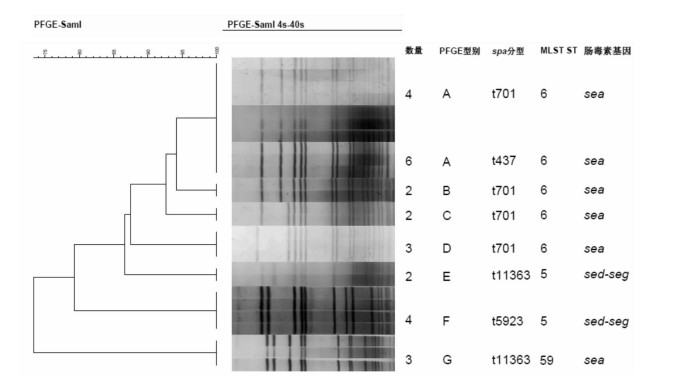Molecular Epidemiological Characteristics of Staphylococcus aureus Strains Associated with Food Poisoning in Xi'an from 2013 to 2017
-
摘要:
目的 了解2013-2017年西安市食物中毒中分离的金黄色葡萄球菌(staphylococcus aureus,S.aureus)分子流行特点。 方法 通过脉冲场凝胶电泳(pulsed field gel electrophoresis,PFGE)、多位点序列分型(multilocus sequence typing,MLST)和spa分型方法对八起食物中毒标本的26株金黄色葡萄球菌进行分子分型,运用聚合酶链式反应(polymerase chain reaction,PCR)检测相关肠毒素基因。 结果 26株S.aureus PFGE可分为7种型别(A-G);MLST可分为3种序列型(ST6,ST5和ST59)。其中,ST6占65.38%,为主要型别;spa可分为4种型别(t437,t701,t11363和t5923),优势型别为t701,占65.38%。肠毒素基因检测中,sea基因占76.92%(20/26);sed-seg基因占23.08%(6/26);其它肠毒素基因未检出。 结论 2013-2017年西安市食物中毒标本中分离培养的S.aureus的主要流行型别为ST6-t701-sea,并首次检出含有seg新型肠毒素基因。PFGE、MLST和spa分型三种方法相结合全面的了解菌株的分子流行特点。 Abstract:Objective To understand the molecular epidemiological characteristics of staphylococcus aureus(S.aureus), which was isolated from food poisoning in Xian between 2013 and 2017. Methods A total of 26 S.aureusisolates from 8 outbreaks were analyzed by using pulsed field gel electrophoresis(PFGE), multilocus sequence typing(MLST) and spa typing. polymerase chain reaction(PCR) analysis was used to analyze the staphylococcal enterotoxin genes sea to sei. Results 26 strains of S.aureus were divided into 7 types of A-G by PFGE; They were divided into 3 types by MSLT, ST6 accounted for 65.38% which was the main type; They were Divided into 4 types by spa typing, t701 accounted for 65.38% which is the dominant type. The sea accounted for 76.92% (20/26) in the enterotoxin gene testing; sed-seg accounted for 23.08% (6/26); other enterotoxin genes were not detected. Conclusion The predominant type of S.aureus isolated from food poisoning in Xi'an was ST6-t701-seaprofile from 2013 to 2017. The first detection of the new enterotoxin gene seg, PFGE, MLST and spa typing were combined to fully understand the molecular epidemic characteristics of strains. -
Key words:
- Staphylococcus aureus /
- Molecular typing /
- Food poisoning
-
表 1 8起S.aureus食物中毒流行病学数据
Table 1. Epidemiological data for 8 cases of S. aureus food poisoning
日期 地点 人数 潜伏期(h) 症状 中毒食物 1 2013/06/13 小吃城 4 2.0~4.0 呕吐 炒饭 2 2014/05/06 学校 10 1.5~5.0 呕吐、腹泻 土耳其烤肉 3 2015/01/12 幼儿园 5 1.5~4.0 呕吐、恶心 三明治、饼干 4 2016/05/04 学校 8 2.0~5.0 呕吐、腹泻 蒜苔炒肉、包菜、炒青椒 5 2016/060/6 小吃城 4 1.0~3.0 呕吐、腹泻 烤鸡肉 6 2016/08/01 酒店 8 2.0~6.0 呕吐、腹泻 排骨、炒饭、肥牛、蛋糕、色拉卷、果仁脆 7 2016/10/16 酒店 5 1.5~3.0 呕吐、头疼 牛肉、马面鱼 8 2017/05/08 酒店 6 1.5~5.0 呕吐、腹泻 凉拌牛肉和黄瓜 表 2 26株S.aureus分离来源及三种方法分型结果
Table 2. Sources of 26 S. aureus isolates and their typing results by three methods
序号 来源(菌株) MLST spa分型 PFGE 肠毒素基因 1 食物(1) ST6 t701 C sea 肛拭子(1) ST6 t701 2 食物(1) ST6 t701 D sea 呕吐物(1) ST6 t701 粪便(1) ST6 t701 3 食物(2) ST6 t701 B sea 4 食物(3) ST59 t11363 G sea 5 粪便(2) ST6 t701 A sea 呕吐物(1) ST6 t701 食物(1) ST6 t701 6 食物(6) ST6 t437 A sea 7 食物(2) ST5 t11363 E sed-seg 8 食物(3) ST5 t5923 F sed-seg 环境(1) ST5 t5923 -
[1] 刘秀梅, 陈艳, 樊永祥, 等. 2003年中国食源性疾病暴发的监测资料分析[J]. 卫生研究, 2006, 35(2): 201-204. DOI: 10.3969/j.issn.1000-8020.2006.02.020.Liu XM, Chen Y, Fan YX, et al. Foodborne Diseases occurred in 2003-report of the national foodborne Diseases surveillance system, China[J]. Journal of Hygiene Research, 2006.35(2): 201-204. DOI: 10.3969/j.issn.1000-8020.2006.02.020. [2] Mohammed E Y, Abdel-Rhman S H, Barwa R, et al. Studies on enterotoxins and antimicrobial resistance in staphylococcus aureus isolated from various sources[J]. Advances in Microbiology, 2016, 6(4): 263-275. DOI: 10.4236/AIM.2016.64026. [3] Sergeev N, Volokhov D, Chizhikov V, et al. Simultaneous analysis of multiple staphylococcal enterotoxin genes by an oligonucleotide microarray assay[J]. Journal of Clinical Microbiology, 2004, 42(5): 2134-2143. DOI: 10.1128/JCM.42.5.2134-2143.2004. [4] 张锋, 刘萍, 赵永钢, 等. 西安市2011-2013年食物中毒分析[J]. 公共卫生与预防医学, 2014, 25(6): 85-87. https://www.cnki.com.cn/Article/CJFDTOTAL-FBYF201406025.htmZhang F, Liu P, Zhao YG, et al. Analysis of food poisoning in Xian from 2011 to 2013[J]. J of Pub Health and Prev Med, 2014, 25(6): 85-87. https://www.cnki.com.cn/Article/CJFDTOTAL-FBYF201406025.htm [5] Becker K, Roth R, Peters G. Rapid and specific detection of toxigenic Staphylococcus aureus: use of two multiplex PCR enzyme immunoassays for amplification and hybridization of staphylococcal enterotoxin genes, exfoliative toxin genes, and toxic shock syndrome toxin 1 gene[J]. J Clin Microbiol, 1998, 36(9): 2548-2553. doi: 10.1128/JCM.36.9.2548-2553.1998 [6] Mclauchlin J, Narayanan GL, Mithani V, et al. The detection of enterotoxins and toxic shock syndrome toxin genes in staphylococcus aureus by polymerase chain reaction[J]. J Food Prot, 2000, 63(4): 479-488. DOI: 10.4315/0362-028x-63.4.479. [7] Hunter PR, Gaston MA. Numerical index of the discriminatory ability of typing systems: an application of simpson's index of diversity[J]. J Clin Microbio, 1988, 26(11): 2465-2466. doi: 10.1128/JCM.26.11.2465-2466.1988 [8] 胡守奎, 胡万富, 王敏, 等. 安徽省2008-2010年宋内氏志贺菌分子流行病学分析[J]. 中华疾病控制杂志, 2013, 17(11): 959-962. http://zhjbkz.ahmu.edu.cn/article/id/JBKZ201311012Hu SK, Hu WF, Wang M, et al. The molecular epidemiological analysis on shigella sonnei strains isolated from Anhui province, 2008-2010[J]. Chi J Dis Control Prev, 2013, 17(11): 959-962. http://zhjbkz.ahmu.edu.cn/article/id/JBKZ201311012 [9] Maiden MC, Bygraves JA, Feil E, et al. Multilocus sequence typing: a portable approach to the identification of clones within populations of pathogenic microorganisms[J]. Proc Natio Sci U S A, 1998, 95(6): 3140-3145. DOI: 10.1073/PNAS.95.6.3140. [10] Yan X, Wang B, Tao X, et al. Characterization of staphylococcus aureus strains associated with food poisoning in Shenzhen, China[J]. Appl Environ Microbiol, 2012, 78(18): 6637-6642. DOI: 10.1128/AEM.01165-12. [11] Cha JO, Lee JK, Jung YH, et al. Molecular analysis of staphylococcus aureus isolates associated with staphylococcal food poisoning in South Korea[J]. J Appl Microbiol, 2006, 101(4): 864-871. DOI: 10.1111/j.1365-2672.2006.02957.x. [12] Sato'o Y, Omoe K, Naito I, et al. Molecular epidemiology and identification of a staphylococcus aureus clone causing food poisoning outbreaks in Japan[J]. J Clin Microbio, 2014, 52(7): 2637-2640. DOI: 10.1128/JCM.00661-14. [13] 邹自英, 韩黎, 熊杰, 等. 金黄色葡萄球菌临床分离株spa分型和耐药特征研究[J]. 中国感染与化疗杂志, 2014, 14(2): 142-145. DOI: 10.16718/j.1009-7708.2014.02.008.Zou ZY, Han L, Xiong J, et al. spa typing and resistance profile of Staphylococcus aureus isolated from clinical specimens[J]. Chin J Infect Chemother, 2014, 14(2): 142-145. DOI: 10.16718/j.1009-7708.2014.02.008. [14] 汪永禄, 王多春, 詹圣伟, 等. 马鞍山市金黄色葡萄球菌鉴定及SPA基因多态性分析[J]. 公共卫生与预防医学, 2011, 22(4): 50-53. https://www.cnki.com.cn/Article/CJFDTOTAL-FBYF201104021.htmWang YL, Wang DC, Zhan SW, et al, Identification of Staphylococcus aureus and spa polymorphisms in maanshan city[J]. J of Pub Health and Prev Med, 2011, 22(4): 50-53. https://www.cnki.com.cn/Article/CJFDTOTAL-FBYF201104021.htm [15] 袁梦, 袁月明, 罗锦雁, 等. 金黄色葡萄球菌毒力基因检测及Spa分型研究[J]. 疾病监测, 2016, 31(7): 603-608. DOI: 10.3784/j.issn.1003-9961.2016.07.015.Yuan MY Yue M, Luo JY, et al. Virulence gene detection and spa typing of staphylococcus aureus[J]. Disease Surveillance, 2016, 31(7): 603-608. DOI: 10.3784/j.issn.1003-9961.2016.07.015. [16] 李琼琼, 范一灵, 宋明辉, 等. 食源性金黄色葡萄球菌肠毒素及其检测方法[J]. 食品安全质量检测学报, 2016, 7(2): 555-560. https://www.cnki.com.cn/Article/CJFDTOTAL-SPAJ201602027.htmLi QQ, Fan YM, Song MH, et al. Research advances on foodborne staphylococcal enterotoxins and its detection methods[J]. Journal of Food Safety and Quality, 2016, 7(2): 555-560. https://www.cnki.com.cn/Article/CJFDTOTAL-SPAJ201602027.htm -





 下载:
下载:

